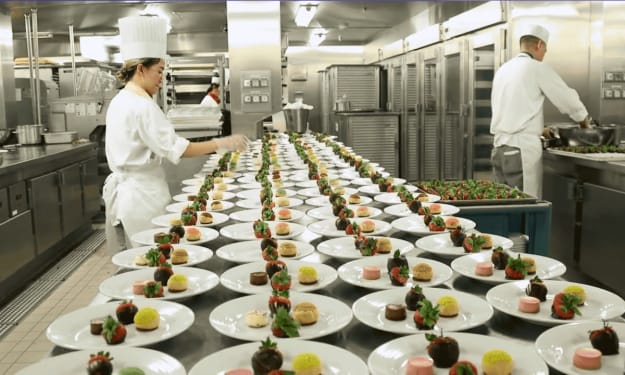
The culinary operation behind the scenes of Singapore Airlines' economy class meals is nothing short of a marvel. In a bustling catering facility like the one described, the production line churns out an impressive quantity of meals each day to meet the demands of nearly 20 million passengers annually. Led by Anthony, who oversees the entire operation, the kitchen operates on a massive scale, with a budget of $500 million per year allocated for food procurement.
To put things into perspective, the facility produces around 6,000 to 7,000 omelets daily, a staple dish for economy class passengers. With such high production volumes, efficiency and precision are paramount. Chefs work tirelessly to ensure that every element of the meal is prepared to perfection, adhering to strict timelines and quality standards.
The catering facility operates around the clock, 365 days a year, to meet the non-stop demand for inflight meals. From lobster tails to rice, the kitchen handles a staggering amount of ingredients and dishes each month. However, despite the meticulous planning and execution, ensuring consistent taste and quality at 35,000 feet presents unique challenges.
Historically, the flavor of inflight meals could vary due to the conditions inside the plane. Factors such as cabin pressure, dryness, and noise can affect taste perception, leading to bland or altered flavors. This phenomenon has plagued airlines for decades, prompting aircraft manufacturers and airlines to explore solutions to enhance the inflight dining experience.
Singapore Airlines, known for its exceptional service and attention to detail, is at the forefront of addressing these challenges. With a keen focus on innovation and customer satisfaction, the airline collaborates closely with its catering partner, SATs, to develop hundreds of new menus each year. Creating a single dish can take up to 9 to 12 months of meticulous planning and testing to ensure it meets the airline's exacting standards.
Menus are tailored to cater to diverse tastes and preferences, with options ranging from Japanese and Chinese cuisine to Singaporean and Western fare. The airline serves passengers departing from 77 different cities, offering region-specific dishes to enhance the inflight experience. Whether traveling in first class or economy, passengers can expect a thoughtfully curated menu that includes a balance of proteins, vegetables, starches, and sauces.
In the catering facility, food preparation is a well-coordinated process involving over a thousand workers divided into specialized stations. From grilling meats to boiling noodles and preparing sauces, each task is performed with precision to ensure consistency and efficiency. Ingredients are carefully selected and handled to maintain freshness and quality throughout the production process.
One of the key challenges in inflight catering is ensuring that meals taste as good in the air as they do on the ground. To address this, Singapore Airlines employs innovative techniques, such as simulating inflight conditions to test the taste and texture of food. By understanding how factors like cabin pressure and humidity impact taste perception, chefs can adjust recipes and ingredients accordingly.
Additionally, the airline invests in state-of-the-art aircraft with improved cabin environments to enhance the dining experience for passengers. Newer planes, such as the A350s, A380s, and 787s, feature pressurized cabins and higher humidity levels, creating a more comfortable environment for passengers. These enhancements help to preserve the integrity of flavors and ensure that inflight meals are enjoyed to the fullest.
Despite the meticulous planning and preparation, the final challenge lies in reheating the food onboard. Flight attendants are equipped with small ovens to heat meals, requiring chefs to anticipate how dishes will fare during the reheating process. By cooking dishes halfway and avoiding items that don't travel well, chefs ensure that inflight meals maintain their quality and flavor.
In conclusion, the culinary operation behind Singapore Airlines' economy class meals is a testament to precision, innovation, and dedication to customer satisfaction. From the bustling catering facility to the inflight dining experience, every aspect of the process is carefully orchestrated to deliver a memorable culinary journey for passengers around the world. With a commitment to excellence and a relentless pursuit of perfection, Singapore Airlines continues to set the standard for inflight dining in the aviation industry.
About the Creator
Gunduz
Explore captivating tales and thought-provoking perspectives. Join me for an enlightening journey through imagination and insight.
Contact:
Instagram: gunduz.asadli






Comments
There are no comments for this story
Be the first to respond and start the conversation.